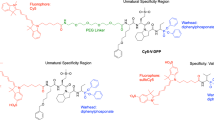Abstract
α 1-Antichymotrypsin, a member of the serpin family of serine proteinase inhibitors, has been reported to inhibit chymotrypsin by a modified version of the suicide substrate reaction mechanism operative for other serpins. To investigate if this mechanism is also applicable to the inhibition of cathepsin G by this serpin, the effect of temperature on the reaction between cathepsin G andα 1-antichymotrypsin has been examined by SDS-PAGE and stoichiometric titrations. At 0° C, a cathepsin G-α 1-antichymotrypsin complex of Mr 89,250 is formed which, at 38° C, was cleaved by free enzyme to give a stable complex of Mr 80,250. The reaction stoichiometry at 0°C was 1.53, which decreased to 1.30 at 38°C, consistent with an decrease in the substrate pathway. These data are compatible with the modified suicide substrate reaction scheme. The formation of three products (cleaved inhibitor and two forms of complex) from the reaction and the potential for differential product formation suggests that modulation of the suicide substrate mechanism may play a role in the regulation of inflammatory processes mediated by cathepsin G.
Similar content being viewed by others
References
Rest, R. F. 1988. Human neutrophil and mast cell proteases implicated in inflammation.Methods Enzymol. 163:309–327.
Capodici, C., andR. A. Berg. 1989. Cathepsin G degrades denatured collagen.Inflammation 13:137–145.
Capodici, C., G. Muthukumaran, M. A. Amoruso, andR. A. Berg. 1989. Activation of neutrophil collagenase by cathepsin G.Inflammation 13:245–258.
Kubes, P., R. Smith, M. D. Grisham, andD. N. Granger. 1993. Neutrophil-mediated proteolysis. Differential roles for cathepsin G and elastase.Inflammation 17:321–332.
Bao, J.-J., R. N. Sifers, V. J. Kidd, F. D. Ledley, andS. L. C. Woo. 1987. Molecular evolution of serpins: Homologous structure of the humanα 1-antichymotrypsin andα 1-antitrypsin genes.Biochemistry 26:7755–7759.
Beatty, K., J. Bieth, andJ. Travis. 1980. Kinetics of association of serine proteinases with native and oxidizedα-1-proteinase inhibitor andα-1-antichymotrypsin.J. Biol. Chem. 255:3931–3934.
Schechter, N. M., J. L. Sprows, O. L. Schoenberger, G. S. Lazarus, B. S. Cooperman, andH. Rubin. 1989. Reaction of human skin chymotrypsin-like proteinase chymase with plasma proteinase inhibitors.J. Biol. Chem. 264:21308–21315.
Rubin, H., Z. M. Wang, E. Nickbarg, S., McLarney, N. Naidoo, O. L. Schoenberger, J. L. Johnson, andB. S. Cooperman. 1990. Cloning, expression, purification, and biological activity of recombinant native and variant human α1-antichymotrypsins.J. Biol. Chem. 265:1199–1207.
Cooperman, B. S., E. Stavridi, E. Nickbarg, E. Rescorla, N. M. Schechter, andH. Rubin. 1993. Antichymotrypsin interaction with chymotrypsin: Partitioning of the complex.J. Biol. Chem. 268:23616–23625.
Schechter, N. M., L. M. Jordan, A. M. James, B. S. Cooperman, Z. M. Wang, andH. Rubin. 1993. Reaction of human chymase with reactive site variants of α1-antichymotrypsin: Modulation of inhibitor versus substrate properties.J. Biol. Chem. 268:23626–23633.
Björk, I., K. Nordling, I. Larsson, andS. T. Olson. 1992. Kinetic characterization of the substrate reaction between a complex of antithrombin with a synthetic reactive-bond loop tetradecpeptide and four target proteinases of the inhibitor.J. Biol. Chem. 26:19047–19050.
Patston, P. A., P. Gettins, J. Beechem, andM. Schapira. 1991. Mechanism of serpin action: Evidence that C1-inhibitor functions as a suicide substrate.Biochemistry 30:8876–8882.
Hopkins, P. C. R., R. W. Carrell, andS. R. Stone. 1993. Effects of mutations in the hinge region of serpins.Biochemistry 32:7650–7657.
Waley, S. G. 1985. Kinetics of suicide substrates: Practical procedures for determining parameters.Biochem. J. 227:843–849.
Gettins, P. G. W., P. A. Patston, andM. Schapira. 1993. The role of conformational change in serpin structure and function.BioEssays 15:461–467.
Laemmli, U. K. 1970. Cleavage of structural proteins during the assembly of the head of bacteriophage T4.Nature 227:680–685.
Laine, A., M. Davril, andA. Hayem. 1982. Interaction between human serumα 1,-antichymotrypsin and human leukocyte cathepsin G: Complex formation and production of a modified inhibitor.Biochem. Biophys. Res. Commun. 105:186–193.
Kurdowska, A., andJ. Travis. 1990. Acute phase protein stimulation byα 1-antichymotrypsin-cathepsin G complexes: Evidence for the involvement of interleukin-6.J. Biol. Chem. 265:21023–21026.
Schuster, M. G., P. M. Enriquez, P. Curran, B. S. Cooperman, andH. Rubin. 1992. Regulation of neutrophil superoxide by antichymotrypsin-chymotrypsin complexes.J. Biol. Chem. 267:5056–5059.
Potempa, J., D. Fedak, A. Dubin, A. Mast, andJ. Travis. 1991. Proteolytic inactivation ofα-1-chymotrypsin: Sites of cleavage and generation of chemotactic activity.J. Biol. Chem. 266:21482–21487.
Perlmutter, D. H., G. I. Glover, M. Rivetna, C. S. Schasteen, andR. J. Fallon. 1990. Identification of a serpin-enzyme complex receptor on human hepatoma cells and human monocytes.Proc. Natl. Acad. Sci. U.S.A. 87:3753–3757.
Joslin, G., A. Wittwer, S. P. Adams, D. M. Tollefsen, A. August, andD. H. Perlmutter. 1993. Cross-competition for binding ofα 1-antitrypsin (α 1-AT)-elastase complexes to the serpin-enzyme complex receptor by other serpin-enzyme complexes and by proteolytically modifiedα 1-AT.J. Biol. Chem. 268:1886–1893.
Patston, P. A., R. L. Medcalf, Y. Kourteva, andM. Schapira. 1993. C1-inhibitor-serine proteinase complexes and the biosynthesis of C1-inhibitor by Hep G2 and U 937 cells.Blood 82:3371–3379.
Patston, P. A., P. G. W. Gettins, andM. Schapira, 1994. Serpins are suicide substrates: Implications for the regulation of proteolytic pathways.Semin. Thromb. Hemost. 20:410–416.
Author information
Authors and Affiliations
Additional information
Supported by National Institutes of Health grant HL-49242.
Rights and permissions
About this article
Cite this article
Patston, P.A. Studies on inhibition of neutrophil cathepsin G byα 1-antichymotrypsin. Inflammation 19, 75–81 (1995). https://doi.org/10.1007/BF01534382
Issue Date:
DOI: https://doi.org/10.1007/BF01534382




